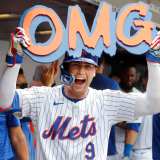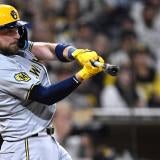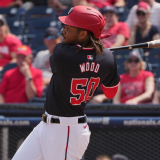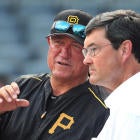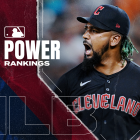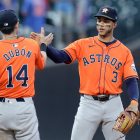The NL Central could be the most fascinating division in baseball this year.
The defending champs from Milwaukee will look to repeat, following a deep playoff run keyed by Christian Yelich, Lorenzo Cain and multiple other shrewd acquisitions. The Cubs are three years removed from a historic World Series win, facing some roster question marks but still armed with plenty of elite talent. The Cardinals got sick of missing the playoffs three straight years, so they aggressively scooped up All-Stars Paul Goldschmidt and Andrew Miller. Even the Cincinnati Reds, the perennial doormats who haven't won a playoff series since 1995, went on a shopping spree, shockingly acting as the win-now-focused team when the mega-revenue Dodgers decided to dump a bunch of salary.
And then there are the Pittsburgh Pirates. If you want to summarize the Pirates' 2018-2019 offseason, and just about every season since the end of their three-year run in the early 90s, this'll do it:
Even after signing free-agent outfielder J.B. Shuck to a minor-league contract, #Pirates still looking at other OFs - Brandon Guyer, Cameron Maybin, etc. - on similar deals.
— Ken Rosenthal (@Ken_Rosenthal) January 31, 2019
There's nothing inherently wrong with J.B. Shuck, Brandon Guyer and Cameron Maybin, especially when your starting outfield is the excellent trio of Corey Dickerson, Starling Marte, and Gregory Polanco (whenever Polanco makes it back from his September shoulder injury). Under the right circumstances, there's also nothing wrong with swinging for singles during the offseason, the way the Bucs have in pursuing backup outfielders to go with the minor acquisitions of Lonnie Chisenhall, Erik Gonzalez, Jordan Lyles and Brandon Maurer.
The problem is one of context. The Pirates won 82 games last year. They've got a solid, young core of talent, led by that outfield, and some promising pitchers. Every other team in the NL Central is playing to win now, either through moves made this winter (Cardinals, Reds), or recent winters (Brewers, Cubs). They spent 20 years between the end of the Barry Bonds Era and their next playoff berth, made the postseason three years in a row, and have again fallen back to mediocrity.
And then there's this: For more than a quarter-century, the Pirates have developed a reputation as one of the thriftiest organizations in all of North American sports.
It wasn't always this way. In the late 1980s and early 1990s, MLB payroll distribution was flatter than it is now. Moreover, market size played less of a role in determining which teams spent the most money -- in other words, it wasn't always the Yankees, Dodgers and Red Sox, followed by everyone else.
Granted, the 1988 Pirates were one of the lowest-spending teams in the sport, shelling out a total of $7.6 million on Opening Day ... for the entire roster. (All payroll data before 2000 comes courtesy of USA Today's excellent historical salary database.) A look at that season's roster helps you see how and why that happened. Every member of that season's starting eight, and the next eight players with the most playing time off the bench, plus all five of the team's top relievers and four of the top five starting pitchers, were all under 30 years old. Most of the team's best players were significantly younger than 30, at an age where they were either receiving light arbitration awards, or making roughly the league minimum. That list included Bonds (23), Bobby Bonilla (25), Doug Drabek (25), John Smiley (23) and numerous others.
That's the dream for any franchise, rich or slightly less rich (they're all rich, they just won't open their books to show you). Develop and acquire a group of young talent that can produce and work cheaply, then let those players grow up together, hopefully culminating in a winning team. And that's just what happened to the Pirates. Fast forward two years to the 1990 season, and the team's payroll had more than doubled. This wasn't a case of rampant free-agent spending either; it was those same young players improving every year, and getting paid accordingly as they racked up more service time. Not coincidentally, that 1990 club charged to an NL East title, posting the franchise's best record since the legendary We Are Family team of 1979. That would be the first of three straight division titles that those Pirates teams would win. By that 1992 season, the club's payroll had more than quadrupled in a span of just four years.
The reckoning came quickly after that. Knocked out of the postseason on a Game 7 walk-off by unlikely Atlanta Braves playoff hero Francisco Cabrera, the Pirates opted not to re-sign their two-time MVP Bonds, their Cy Young winner Drabek and several other key contributors. The following spring, then-general manager Ted Simmons tried to put a brave face on the Pirates' teardown:
"You can't replace Barry Bonds with one or two players and you can't replace Doug Drabek with one or two pitchers, but you can replace them with 25," Simmons told Los Angeles Times writer Ross Newhan. "We have the best manager in baseball, and he's confident and brave enough to say, 'If you make my club, you'll play.' I don't know what we've got or where we'll finish, but just because we're different now doesn't mean we're worse. I'm not over-promising, but I feel we're at least stable in transition, stable enough not to finish last, where a lot of people are picking us."
Simmons's cautious optimism proved ill-founded. Jim Leyland did last four more seasons as the skipper in Pittsburgh. And the team was in fact stable enough position to avoid finishing last ... those first two years post-Bonds-and-Drabek. Then came two straight cellar-dwelling seasons, and the end of Leyland's time with the Bucs. Newspaper magnate Kevin McClatchy bought the team for $95 million right before what would prove to be Leyland's final season as manager. The following season, the Pirates bottomed out with a $9 million payroll, the second-lowest in all of baseball.
Still, the cheapskate reputation that McClatchy built in the years that followed wasn't entirely justified. After that low-water mark in 1997, the Pirates again started investing in talent, finally topping $57 million in major-league payroll in 2001 -- yet another gigantic jump over the span of four years.
The problem wasn't a lack of spending. It was who the Pirates spent it on. These were the years of Pat Meares and Kevin Young and Derrek Bell. Don't remember Young? He was the middle-of-the-road first baseman who got a four-year, $24 million contract in 1999 that at the time was the richest in franchise history -- a deal the Pirates pegged to expected new revenue streams from the future PNC Park. Don't remember Bell? He netted a two-year deal near the end of his career, then grew so disenchanted with his lack of playing time that he invoked "Operation Shutdown," a self-described work hiatus that eventually ended with Bell spending a full season living on a boat. (He really was a pirate.)
Pittsburgh's payroll did retreat over the next few seasons, never going higher than 21st in MLB. But while the Pirates did stay true to their long-standing philosophy not to sign big-ticket free agents, the bigger problem was systemic failure by the scouting and player development departments to produce the kinds of players they'd want to pay to keep in-house, the way they did with Bonds, Bonilla, Drabek and company (for a while anyway). The Pirates would fail to produce a single winning season during McClatchy's entire tenure as principal owner, or at any point between 1993 and 2012.
The Pirates under principal owner Bob Nutting have been an entirely different team in some ways, and all too familiar in others.
Upon taking the reins from McClatchy, Nutting built a new $5 million baseball academy in the Dominican Republic, chipped in on renovations at the team's spring training complex in Bradenton, Florida, and later spearheaded upgrades at PNC Park. The Pirates also began funneling money into player acquisitions that didn't involve free agency -- specifically, flooding the zone in the draft.
In 2009, they spent $1.2 million to sign pitcher Zack Von Rosenberg in the sixth round, an enormous number that late in the draft, but one that made sense for a team trying to persuade a player ranked 41st overall in that draft by Baseball America to forego a college scholarship. Van Rosenberg was one of three Pirates signees to get over-slot money that year. In 2010, they gave flame-throwing pitcher Stetson Allie a $2.25 million signing bonus, a big number for a second-round pick. Then in 2011, they tossed an enormous $5 million at Josh Bell to sign him in the second round.
These moves made perfect sense given the Pirates' long-standing strategy of trying to build from within rather than chase free agents. It was also a strategy that became ostensibly impossible once Major League Baseball changed its draft rules and made paying draftees way over recommended slot value a costly proposition.
The Pirates also locked down several top homegrown players with long-term contract extensions. On the eve of the 2012 season, they signed young center fielder Andrew McCutchen to a six-year, $51.5 million extension. The move paid instant dividends when McCutchen established new career highs in hits, homers, runs batted in, batting average, and slugging average that season, won the NL MVP award the next season, and locked down four straight top-five MVP finishes.
In spring training 2014, the Pirates signed budding outfield star Starling Marte to an extension that could max out at $53 million and keep him in Pittsburgh for eight years. Infielder Josh Harrison got a four-year extension at the start of the 2015 season. At the start of the 2016 season, the Pirates locked up Gregory Polanco for five years, with club options for two more. They then tossed a three-year, $31 million extension at catcher Francisco Cervelli in May 2016.
All of that was different. So too was the winning. After 20 straight sub-.500 seasons, the Buccos not only crept back above .500 -- they marched to the playoffs three years in a row. If anything, it's that winning that raised expectations, and also made the Pirates' unshakable fiscal prudence all the more frustrating.
Yes, for a period of about five years, the Pirates lobbed multiyear extensions at nearly every useful player on the major-league roster, while even making the right calls on players not worth extending (Pedro Alvarez, hometown kid Neil Walker, etc.). But fans wanted more.
They thought they had David Price at the 2014 trade deadline, only to get nudged aside at the last minute by a three-team deal. Call it the lack of an ace or an offense getting stymied by another ace or just the vagaries of one game, but the Giants flushed the Pirates 8-0 in the Wild Card Game that year, and that was the end of Pittsburgh's season. In 2015, the Pirates zoomed to an 98-win season, but still fell short of winning the NL Central. Forced into another do-or-die situation, they dropped that year's Wild Card Game too.
After that 2015 season, Pirates fans started dreaming of a fourth straight playoff run, hopefully with better October results this time. But after noted magician pitching coach Ray Searage helped J.A. Happ pump up his fastball, the lefty bolted for Toronto instead. The Pirates' alternative offseason lefty pickup Jon Niese turned into a pumpkin the next season, and GM Neal Huntington, a smart and resourceful operator but one also handcuffed by the Pirates' indifference toward free agency, didn't add much else of note. When Francisco Liriano cratered and McCutchen went from MVP-caliber to merely good, the writing was on the wall. The Pirates slid back to sub-.500 baseball. After another losing season in 2017, McCutchen and Gerrit Cole said their goodbyes, with both players traded to greener pastures, and Cole finally becoming the unhittable ace Pirates fans had long hoped to see, but rarely did.
When it comes to spending money on major-league salaries, there will always be a spectrum: If some teams are going to finish in the top 10 of the league, by definition others will end up in bottom 10. But those rankings should be subject to change, depending on circumstances. When the tiny-market Kansas City Royals finally developed the core of young talent they needed to contend, the team spent real money, both to keep those players in town as long as possible and to augment the team by adding capable veterans like James Shields, Johnny Cueto, and Ben Zobrist. That's how the team that finished dead-last in end-of-season payroll in 2011 rose to 19th during the Royals' Cinderella AL pennant-winning run of 2014, to 13th during their incredible World Series-winning season of 2015, all the way to eighth in the majors in 2017 as K.C. gave it one last shot before bidding goodbye to Eric Hosmer, Lorenzo Cain, Mike Moustakas and others.
Unlike those Royals, the Pirates never change all that much. Via the Cot's baseball contracts page, here are the Pirates' salary numbers dating back to 2000 (MLB rank in brackets):
| Year | Opening Day Payroll | 40-man year-end payroll (MLB rank) |
|---|---|---|
2018 | $86,340,000 | $103,837,992 (27) |
2017 | $95,807,004 | $109,460,508 (24) |
2016 | $99,945,500 | $109,671,516 (24) |
2015 | $90,053,00 | $95,889,960 (24) |
2014 | $71,929,333 | $78,379,602 (27) |
2013 | $66,805,000 | $74,608,266 (25) |
2012 | $51,932,333 | $61,300,313 (29) |
2011 | $42,047,000 | $51,784,810 (27) |
2010 | $39,068,000 | $44,146,967 (29) |
2009 | $48,693,000 | $47,991,132 (28) |
2008 | $48,689,783 | $50,764,410 (29) |
2007 | $38,537,823 | $51,360,907 (27) |
2006 | $46,717,750 | $43,443,685 (28) |
2005 | $38,133,000 | $30,139,200 (29) |
2004 | $32,227,929 | $32,507,271 (28) |
2003 | $54,812,429 | $62,314,723 (21) |
2002 | $42,323,599 | $46,059,984 (24) |
2001 | $57,760,833 | $46,661,290 (22) |
2001 | $29,600,000 | $33,630,256 (25) |
That is some truly startling consistency. In each of the past 19 seasons, the Pirates have finished the year as a bottom-10 payroll team, with 11 appearances in the bottom five. Credit ownership for green-lighting all those productive extensions, and for spending money aggressively on the draft before the rules changed. But the best and most successful teams can and do adjust on the fly when circumstances call for it.
In a baseball landscape that features gigantic corporate takeovers that funnel more than $50 million into the coffers of each MLB team, on top of growing TV and Internet revenue that can override disappointing attendance figures, leading to economic volcanoes for even small-market clubs, what excuse does a team have for almost entirely avoiding one important method of player acquisition?
Hell, if said team wanted to try and improve on those constantly disappointing attendance figures, wouldn't making an offseason splash or two be a logical way to try to do it? Especially during a stretch of three straight playoff berths that all ended with early ousters? Or say, this winter, when inertia by many of the biggest-market teams in baseball could open the door for bargains would motivate so many other teams to take action (including the Reds -- the Reds!)?
The good news is that Huntington and company believe they might have a young core that can rival the McCutchen-led group that surged to three playoff berths, if not necessarily one to rival Bonds, Bonilla, Drabek, and friends. Jameson Taillon, Trevor Williams, Joe Musgrove, Kyle Crick, Richard Rodriguez, Adam Frazier, Colin Moran and Bell are all 20-something talents who haven't yet hit arbitration. That's a young group that could support that excellent outfield, one that could flourish even after the potentially ill-fated trade of exciting young players Tyler Glasnow and Austin Meadows for Chris Archer last summer -- a rare go-for-it move that mind end up backfiring if Archer can't rediscover his old form, and stop his fastball from getting clobbered.
If you're a Pirates die-hard, there's good reason to feel disappointed. You root for an organization that's well run by sharp people. You lived through decades of misery, and got the payoff that comes with multiple playoff runs. But after watching long-time losers like the Cubs, Astros and even the Royals go all the way, you're still waiting for your turn.
Add it all up, and here's the harsh truth: Every year that ownership doesn't do enough to invest in the product is another year of robbing the fans.




